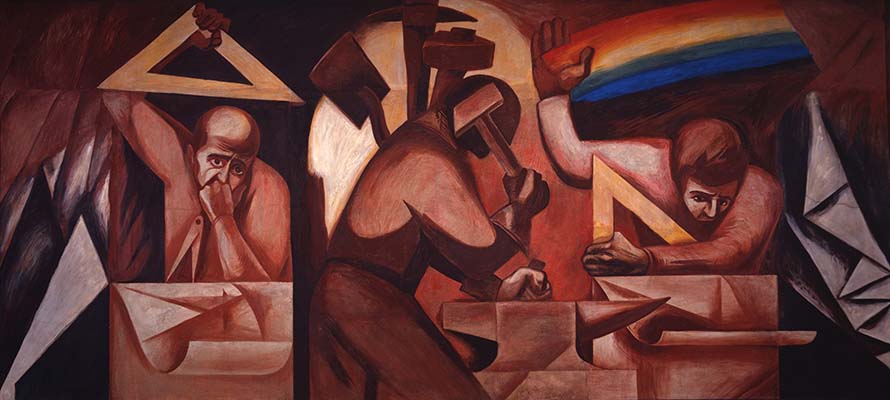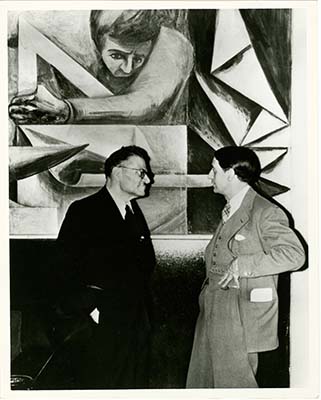
The New School Art Collection Awarded $500,000 by the Mellon Foundation to Chart a Sustainable Course for Its Future
A new $500,000 grant from The Andrew W. Mellon Foundation has provided The New School with an extraordinary opportunity to chart a sustainable course for the art collection’s future and to make central its role in supporting critical thinking and discourse through the work of contemporary artists and art making practices. The grant also provides needed funding for a comprehensive preservation study of José Clemente Orozco’s 1931 historic New School mural cycle, Call to Revolution and Table of Universal Brotherhood.
The New School Art Collection plays a vital academic and cultural role at the university, acting as a dynamic curricular catalyst for students, faculty, and staff. Thirteen monumental site-specific works are installed in public spaces throughout the New School campus—from murals and installations in the University Center and Arnhold Hall to glass mosaics in Alvin Johnson/J.M. Kaplan Hall and sculpture in the Vera List Courtyard. Almost fifty percent of the collection’s more than 2,000 works are on view through curated installations throughout campus—in lobbies, hallways, classrooms, staff and faculty offices—inviting community engagement on a daily basis.
“The Mellon Foundation recognized the collection’s significance as an important site of learning and a rich cultural resource not only for The New School community, but for New York City and beyond. Their advocacy at a moment when support for the arts and humanities is at risk is a game-changer. To be able to place the collection front and center in a university-wide conversation to re-imagine a future—and an infrastructure that can support it—as well as continuing the work I had started on the preservation of our Orozco murals is an unprecedented opportunity and a gift” says Silvia Rocciolo, former Director and Senior Curator of the Collection, who was invited to lead the two-year grant project for The New School.
“Even before I joined The New School this past August, I was aware of and deeply impressed by the university’s rich and dynamic art collection and its historic ties to our social justice mission,” said Provost Renée T. White. “The future preservation of these works and their strategic incorporation into The New School’s pedagogy and academic vision is paramount, and we are incredibly grateful to have received this significant support from The Mellon Foundation that allows us to embark on this important work, expertly led by Silvia Rocciolo.”
The grant affords the university the opportunity to undergo a thoughtful strategic planning process that will inform future decisions on the responsible stewardship of the collection and establish more robust ways to fully integrate it into the academic activities of the university. “There have been many fruitful pedagogic collaborations in the past with faculty and students, like our partnership with the Parsons Curatorial Design Research Lab that led to our first collection book I Stand in My Place with My Own Day Here: Site-Specific Art at The New School and accompanying website or supporting student curated exhibitions like Memory is a Tough Place or In the Historical Present. This grant is exciting because there is a possibility of formalizing these kinds of initiatives by integrating the collection into the university’s overarching pedagogic mission,” says Rocciolo.
Beginning in spring 2022, Rocciolo, in collaboration with a Faculty Steering Committee, will hold conversations with students, faculty, staff, trustees, the Provost’s and President’s offices, the Facilities and Finance Departments to ensure that a range of perspectives are integrated into the project. The Faculty Steering Committee members—Julia Foulkes, Professor of History; Lydia Matthews, Professor of Visual Culture; and Radhika Subramaniam, Associate Professor of Visual Culture—were invited for their experience in incorporating the collection into their teaching, curatorial practice, and research over the years.
“Faculty have worked with Silvia or used the collection in their courses, but that has been individually defined by specific faculty who noticed the artwork around us,” says Foulkes. “This is an opportunity to imagine what could be done in collaboration through building up the collection’s resources. For example, we may have a better way to understand what we have in the collection that could help faculty discover how they could use it, rather than just relying on what they see in a hallway.”
“We’re grateful for Mellon’s recognition of the collection as valuable and requiring stewardship. They have been partners and instigators—affirming the importance of a collection like this in an educational institution and in New York City,”says Subramaniam. “My own work is partly curatorial, but it’s also profoundly interdisciplinary, so I am eager not just to consider the place of the art collection in an art and design education but the ways in which thinking and learning are transformed when art mingles with other disciplines as an integral part of the educational mix.”
“Receiving this grant is a pedagogical opportunity, not only for us as educators to re-envision teaching methods, but also for our students. They will once again be able to access the collection as a cultural and curatorial resource. Learning how to research, interpret, display and care for an art collection offers a certain type of training that enhances various students’ career paths,” says Matthews. “There are also new environmental /social justice initiatives at the university, along with recently hired faculty interested in cross-disciplinary dialogue. Our work involves bringing people to the table and facilitating brainstorming sessions on how to support and imagine multiple forms of engagement with modern and contemporary art.”
In addition to providing support for strategic planning, the Mellon grant will also fund the development of a study of the preservation of the José Clemente Orozco murals in Johnson/Kaplan Hall. Orozco, Diego Rivera, and David Alfaro Siquieros, three of the most prominent Mexican artists of the 20th century, were known as Los Tres Grandes. “These murals are the only remaining public examples of Mexican fresco in New York City and the second of only three murals Orozco produced while in the United States. They are one of our treasures and more importantly, our responsibility” says Rocciolo.

Over the years, the murals have undergone degradation as a result of exposure to humidity and fluctuating temperatures as well as general overuse of the room. “The conservators at Williamstown Art Conservation Center have conducted yearly check-ups of the murals since the murals were restored by the Center in the late 80’s. The last time the conservators visited, they were concerned, warning us that if environmental conditions were not addressed, the murals would not exist in another 100 years. The Mellon Foundation’s support of this work gives us a chance to develop a comprehensive preservation study, so that we can fully understand and prepare for the full scope of work that will be necessary to preserve them.”
To Rocciolo, the Orozco murals framed her curatorial perspective, focusing on artists who responded to critical issues of our time and who fearlessly asserted their own cultural identity. “The Orozco murals are one of our origin stories and at their core, they are part of an institutional identity which informed me as a curator in articulating a vision for the collection with works that are rooted in activism and social justice. The works installed in the University Center—Agnes Denes, Alfredo Jaar, Glenn Ligon and Andrea Geyer—are, for me, an extension of that legacy.”